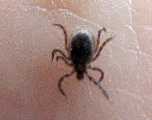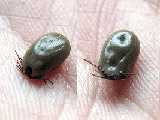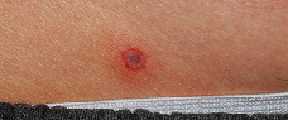Deer Ticks and Deer Tick Bite Information



There are two species of ticks, usually referred to as deer ticks,that are the primary carriers of Lyme disease. They are the blacklegged tick Ixodes scapularis (formerly known as Ixodes dammini), and Ixodes pacificus. I. scapularis is usually found in the North, East and Midwest, while I. pacificus, the western blacklegged tick is found in California and the Pacific Coast. Ixodia ticks are very small. Much smaller than dog or cat ticks. The juvenile is about the size of a pinhead, the largest deer tick being three-sixteenths of an inch. If you have ever had or seen "seed" ticks, you know how small a tick can be. Ticks have eight legs and two body segments.
A Lyme disease infection can occur after a deer tick is attached to a human or other host for twelve to twenty-four hours. An infected deer tick has Borrelia that lives in the tick's mid-gut. Ticks are parasites that insert their mouth parts into their hots and suck blood for several days. When it attaches and feeds, the Borrelia moves into the salivary gland and enters the humans blood,


Obviously finding and removing the tick as quickly as possible is important to preventing infection. The longer the tick feeds, the more likely for it to pass along a disease. There is an incubation time of three to thirty-two days before the disease develops.
Deer ticks can also carry babesiosis and human granulytic ehrlichiosis, two other health threats.
Lyme disease is usually acquired in spring through summer when the tick population is its highest and when more people are outdoors. In the past it was thought that ticks could be in the trees and then drop down on people below. That isn't true. Ticks are in the grass and on the shrubs and attach themselves when a host brushes by them. Ticks can not jump or fly, they only crawl. Deer ticks have several impressive methods for looking for hosts. These include monitoring carbon dioxide levels of victims, body heat, and other chemical indicators.
If you have pets that go outdoors, they should be wearing flea and tick collars, especially in areas close to woods or if deer are coming into your yard. If you have deer coming to your yard regularly, you might consider having your yard treated with a flea/tick control product.
| 



